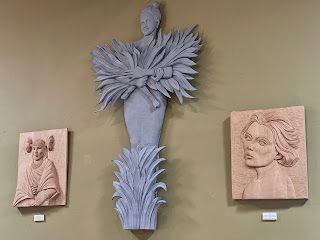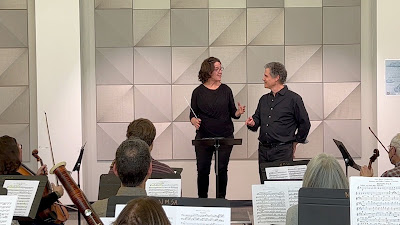
6.14.2023
MAGIC ON THE SANTA FE PLAZA

5.25.2023
ARTFUL WOODCARVING

5.04.2023
THE ART OF CONDUCTING
Years ago I wrote an article for the Boston Globe on how musical conductors learn to conduct. The whole idea fascinated me - how do they practice? Unlike a violinist or a flautist, who simply pull their instrument from a case and begin to play, a student conductor can't whip a 50-piece orchestra out of thin air to practice Brahms' Violin Concerto in D major. So I went to Tanglewood, the Boston Symphony Orchestra's, circa 1937, summer home in Lenox, Massachusetts, and watched as a student conductor stood before two grand pianos practicing conducting a BACH concerto. Note: This was the same music room where legendary conductor Serge Koussevitzky taught Leonard Bernstein.
Well, you can imagine my delight when I received an invitation from Oliver Prezant - the former Musical Director & Conductor of the Santa Fe Community Orchestra to sit in on his conducting class, capturing the nuances with my camera for CHASING SANTA FE. And unlike the Tanglewood students, these five lucky men and women - all musicians taking the next step in their careers - would be practicing with a live ensemble under Oliver's watchful eye.
After the class, I had a thousand questions & Oliver was generous in his responses.
Q. What was YOUR path to conducting?
A. I have been a lecturer and educator for the Santa Fe Opera for 25 years, and I’ve also presented programs for audiences of all ages for the Santa Fe Chamber Music Festival, Performance Santa Fe, Opera Southwest, Chamber Music Albuquerque, Road Scholar and many other organizations. I taught in the Contemporary Music Program, and I taught conducting classes for upper-level students at the College of Santa Fe, and musicians from the community would come in to play for workshops with the students. When the Santa Fe Community Orchestra was looking for a new conductor, I stepped into that role and we presented a varied program of familiar classics, rarely performed works, and works by New Mexico composers.
Q. It has been said that a Conductor is a silent musician whose instrument is made of people. How do you see your role as a conductor.
A. The main thing is that you’re an intermediary between the composer, the musicians, the audience, and the moment. It takes a lot of time to learn conducting, you can’t practice at home, like a violinist or a trombone player. Ideally, you’ve gotten inside the score, you understand the composer and where they’re coming from, how they put music on the page, and how they think and feel, musically. It's not all in the notes, there are all the stylistic aspects and traditions to be observed, and hopefully you've connected with the emotion of the piece and the musical ideas that the composer is exploring. You've gotten to a place where what you're doing is authentic, the result of your involvement, your experience, and your willingness to work with the individuals in the orchestra.
A. With student or amateur orchestras, sometimes it feels like you’re just beating time while everyone learns the notes and gets the sense of the piece. So you don’t get to be expressive or artistic; you have to wait. With professional orchestras, it’s dramatically different. The expectations are high, and when you’re starting out, everyone knows the piece, their part and their instrument better than you do. They size you up in an instant and decide whether they want to play for you. You have to have something special to give that’s not just ego, that makes the experience meaningful. That’s where your preparation and experience and willingness to “be the music” come in. The orchestra has to feel that you’ve gotten close to the composer, you’re with them, and they’re with you. The word ensemble means “together.”
A. I'm hoping to get them deeply involved in the music, so they have something special to give, to share, to allow, through their own understanding of the score and their willingness to work with the musicians. They need to add value to the experience; be authentic, connect with the essence of the music, as they hear it and feel it. When it’s working the orchestra feels it, too, and nothing happens without the orchestra. It's all about relationships and that's a very humbling reality.
Second, I want them to experience the music inside of themselves, deeply. It’s not just waving your arms or keeping time. You need to be “producing” the sound, kind of like singing, but not out loud. When you’re conducting, all of your understanding of the music flows out of you; what you understand and what you feel informs your gestures, your presence, your facial expressions, your body language, your demeanor on the podium. That’s the basis of your authenticity and individuality. The orchestra is a living instrument.
Third, depending on how much experience the conductor who’s studying has, you want to help them learn the basic language of conducting, in order to communicate and bring the music into being when they're on the podium - the frames of the various beat patterns, starting and stopping, showing how the musical phrases are shaped, making meaningful emphasis, getting louder and softer, faster and slower. And, at this stage, controlling the music means being in control of yourself.
In the end, it’s up to the conductors who are studying to go back to their ensembles and unpack what they’ve learned. I’m still learning from the teachers that I studied with years ago. I’m so grateful for what they shared, and I’m so happy to have the opportunity to work with these excellent musicians who are interested in honing their skills.
I want to thank Oliver for allowing me to sit in on his teaching world and to photograph his amazing students as they learn their craft. I was drawn to their faces and hands while conducting and how Oliver interacted with each student. It was a delight to capture this with my camera.

















.JPG)
.jpg)



.jpg)
%20(1).jpeg)






%20-%20Copy.JPG)




%20(1).jpg)












.jpg)
.jpg)




.jpg)
.jpg)
